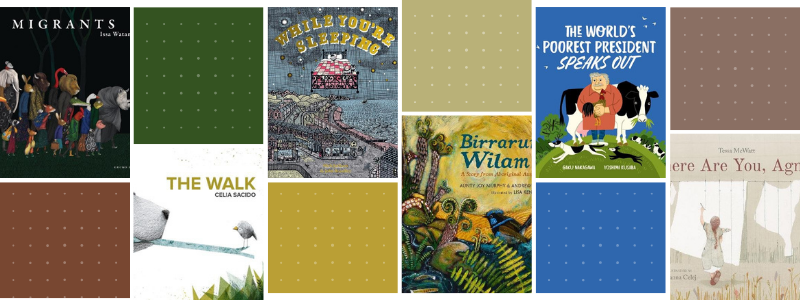We continue highlighting the independent books that were part of Simon Smith’s Best Picture Books 2020.
We do use affiliate links on this website, it helps support this site and the additional work we do to support independent publishing houses. All of the links are to Bookshop, which supports local independent bookshops. A fairer deal for all the smaller businesses in the publishing industry.
The Blurb
The migrants must leave the forest. Borders are crossed, sacrifices made, loved ones are lost. It takes such courage to reach the end. At last the journey is over and the migrants arrive. This is the new place.
With forceful simplicity, Migrants narrates the journey of a group of animals leaving a leafless forest. Borders must be crossed, sacrifices made, loved ones left behind.
Watanabe takes extraordinary care to show the individuality and humanity of each migrant–through the detailed patterns on their clothing, their care of each other as they set up camp, the symbol of the blue ibis showing the connection between past and future, life and death.
The Blurb
A satisfying, uplifting discovery. – Kirkus Reviews
A walk. An unexpected encounter.
Sharing wordless books is a terrific way to build important literacy skills, including listening skills, vocabulary, comprehension and an increased awareness of how stories are structured. And children love them – they can really pore over the pictures and create their own story in their own words.
The Blurb
Travel along Melbourne’s twisting Yarra river in a glorious celebration of indigenous culture and Australia’s unique flora and fauna.
Yarra Riverkeeper Andrew Kelly and Aboriginal Elder of the Wurundjeri people Aunty Joy Murphy join to tell the indigenous and geographical story of Melbourne’s beautiful Yarra river – from its source to its mouth and from its pre-history to the present day. The writing dazzles with poetic descriptions of the trees, plants and wildlife that thrive in harmony along the iconic waterway, while lush and vibrant acrylic paintings from indigenous illustrator Lisa Kennedy make the mighty Yarra come to life – coursing under a starry sky, drawing people to its sunny shores, mirroring a searing orange sunset.
The end matter includes an author’s note and a glossary of the Woiwurrung words used in the story.
The Blurb
Have you ever wondered what’s happening in the world while you’re asleep in your bed?
There’s a whole world of activity out there – from bakers preparing bread and cakes for your table and firefighters waiting patiently for a call, to hospitals helping people have babies and caring for those who are ill. There are lorry drivers making deliveries of food, flowers, toys and more, and postal workers sorting the mail for your morning delivery. There’s also wildlife such as foxes foraging, bats flying, and owls hunting for prey. And then around the world there are children who are playing, learning, eating and reading while you’re tucked up fast asleep.
This is the perfect book for bedtime, opening up a whole world of wonder and imagination for children, and providing food for the imagination if they wake in those early hours. Beautifully written, with lyrical prose, the illustrations are packed with detail.
The Blurb
“A poor person is not someone who has little, but one who needs infinitely more, and more, and more.” Thus spoke Jose Mujica, then the President of Uruguay, before the United Nations in 2012.
Paraphrasing the wisdom of the great thinker Seneca, he asked the world to question the dogma of consumption that has driven us into environmental and economic crisis. Often referred to as the worlds “poorest” president, in part because of his practice of donating 90% of his $12,000 monthly salary to charity, Jose Mujica lived his words and proved that one need not have money to be rich.
In The World’s Poorest President Speaks Out, Jose Mujica’s famous speech comes to life as he asks us to remember our neighbors, our children, and the Earth.
The Blurb
Agnes Martin was born on the Canadian prairies in the early twentieth century. In this imagining of her childhood from acclaimed author Tessa McWatt, Agnes spends her days surrounded by wheat fields, where her grandfather encourages her to draw what she sees and feels around her: the straight horizon, the feeling of the sun, the movement of birds’ wings and the shapes she sees in the wheat.
One day, Agnes’s family moves to a house in a big city. The straight horizon and wheat fields are gone, but Agnes continues to draw what she sees and feels around her. No one except her grandfather understands what she is trying to capture – not her mother, who asks, “Where are you, Agnes?” when she sees her daughter engrossed in her drawing; nor her siblings, who think her art is ugly. Still, Agnes keeps trying to capture what she sees inside her mind.
Agnes Martin grew up to become a famous abstract expressionist artist. Tessa McWatt has written a beautiful story of Agnes’s childhood and how it might have shaped her adult work. Zuzanna Celej’s watercolors adeptly capture Agnes’s world, including hints of the grid paintings that she was later known for, against the backdrop of prairie and city landscapes.
Includes an author’s note with more information about Agnes Martin’s life and the inspiration behind this story.







